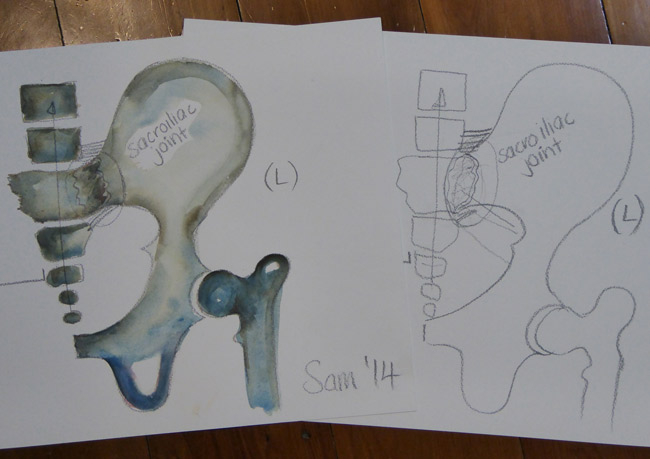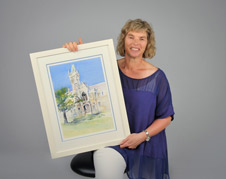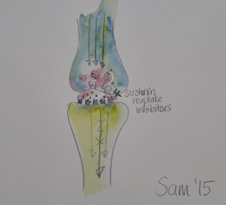
An illustration of the sacroiliac joint by Wellington campus' Dr Sam Murton, whose PhD will examine the use of drawing in explaining ailments to patients.

Dr Sam Murton with one of her non medical paintings - Otago's Clocktower.
Dr Sam Murton utilises both sides of her brain to break down medical jargon for patients.
The University of Otago, Wellington, Senior Lecturer, Trainee Intern convenor and GP often finds herself embracing her artistic talent to draw medical ailments or surgical procedures, when words are not enough to help a patient understand.
“[As doctors] we talk in a medical language that we've spent four years learning, and patients often don't understand it at all. We need to remember that this is complicated and therefore, we need to simplify it,” she says.
Illustrating the situation makes her “talk in lay terms”.
“There are certain things that people really don't get; you start talking and their eyes glaze over. Drawing is a way for people to understand and grasp these concepts.
“When you are doing a drawing, your patient is watching you and you are both engaged in what becomes a comic version of them.”
Dr Murton knows she is not alone in using art in medicine, as many other doctors, nurses and physiotherapists also do it, and is embarking on a PhD study of the practice.
"It seems to appeal to people, as far as it's simplified. They have the ability to see and to really get an understanding of things."
She is going to survey health practitioners to see if, and what, they draw for their patients, along with any other visual aids they use (aside from handing out pamphlets).
From there, she hopes to find some who draw for their patients regularly and interview them about it.
She will also interview their patients to understand what they think and how they feel about drawings being used to help them understand medical terms or procedures.
Part of her PhD will focus on how the interaction between practitioner and patient changes during the process.
“I want to find out what actually goes on when you are drawing a picture for people. I'm also interested to find out if it makes a difference to their health outcome,” she says.
Dr Murton “doodled at school”, taking art until she was 15, before dropping it to concentrate on science subjects.
Alongside her medical studies and subsequent work, she continues to paint, and regularly exhibits her work.
Some of the first drawings she did in a medical setting were based on surgeries. Common topics now include heart disease, cholesterol, or the effect of anti-depressant medication.

Another of Dr Murton's illustrations - this one explaining seratonin reuptake inhibitors.
“Sometimes it's not a physiological drawing, sometimes it's a system.”
While the process can sometimes take a bit of extra time, Dr Murton believes people often “use too many words”, and the time taken doesn't matter so much as the patient gaining an understanding.
Over her 20-year career as a GP, she has filled numerous sketchbooks and admits to “going through more reams of A5 paper than all my staff”.
Tired of repeating herself, she launched a YouTube channel, Visualgp, two years ago to share films of the most common drawings.
The videos feature her sketching while explaining the situation and once the drawing is complete, she applies watercolour, turning it into a piece of art.
She frequently refers patients to the website to view a video relating to them. This not only prepares them for their procedure, or explains their ailment, but helps allay their fears.
“It seems to appeal to people, as far as it's simplified. They have the ability to see and to really get an understanding of things.”
